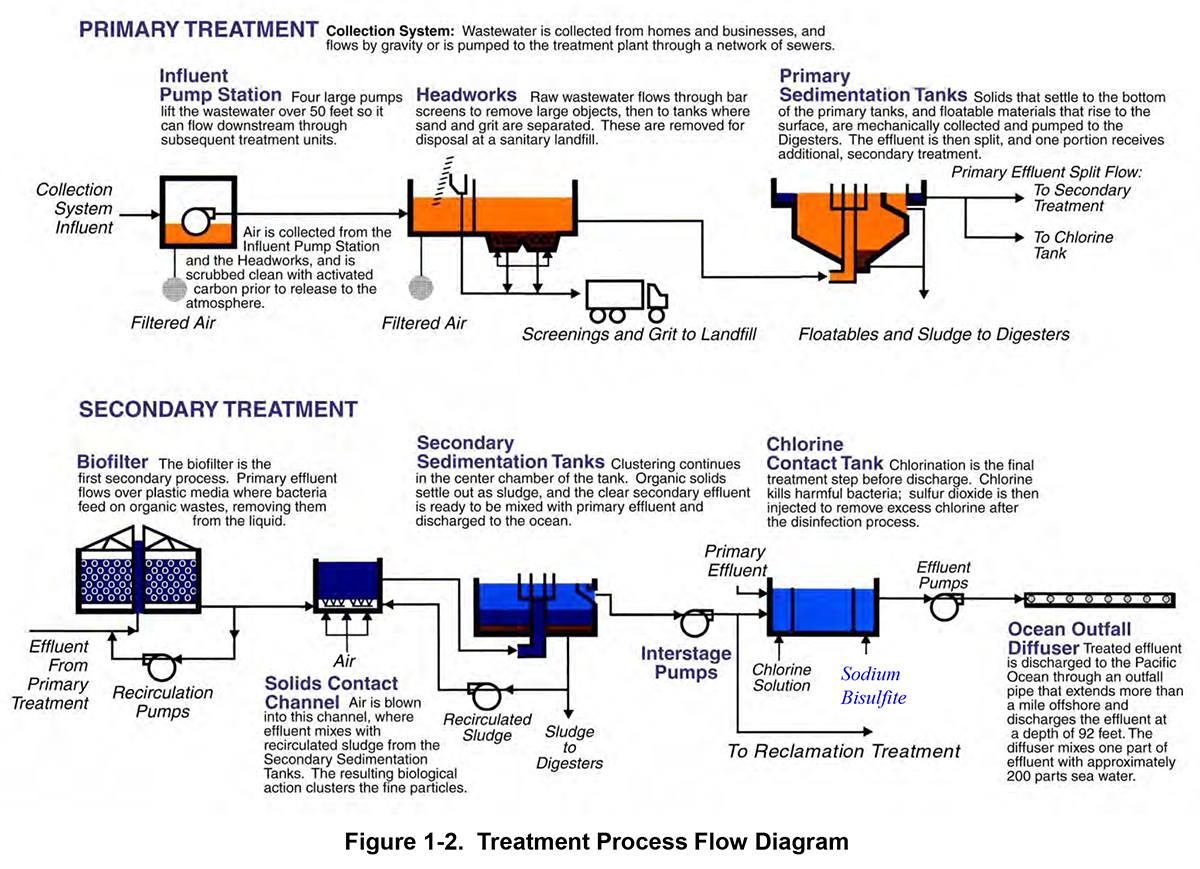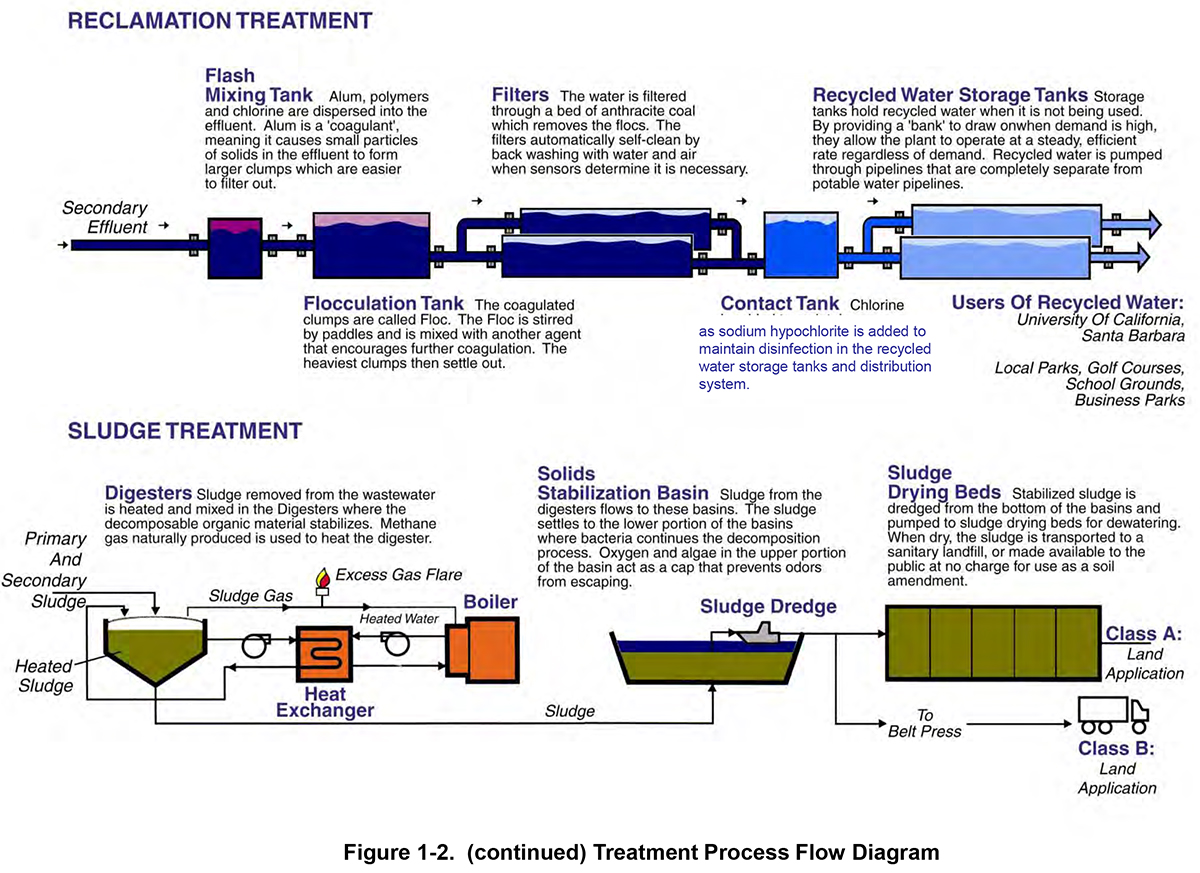Wastewater Treatment
Introduction
Our mission is to protect public health and the environment through the collection and treatment of wastewater and to recover valuable resources such as nutrients, energy, and of course, water. Our purification efforts involve treating wastewater to beyond mandated levels of cleanliness before releasing the purified water that is not recycled for landscaping to the ocean. We focus on finding the most innovative and safest ways to do this in a reasonably-priced manner.
We use three treatment processes: physical, biological, and chemical to achieve the mission. Each step below reflects one or more of these treatment types.
Preliminary Treatment
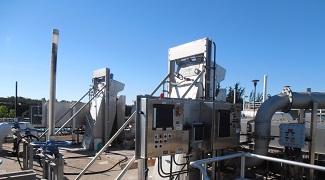
The wastewater treatment process begins with two micro-screen units that remove large and small inorganic objects including so-called "flushable" wipes, plastics, wood, and more. Then two grit chambers with coarse air bubble diffusers thin the water out, allowing small heavy inorganics such as coffee grounds, eggshells, and rocks to drop out and be removed. The wipes often must be removed by hand as they can severely damage the equipment. Wipes and other inorganic material collect in a dumpster before transport to a landfill.
Primary Treatment
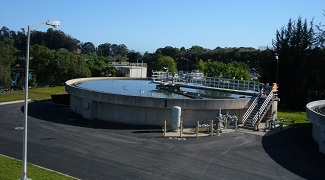
The primary treatment process is a physical process utilizing gravity to remove about 69% of the organic solids from the wastewater.
Our primary treatment process consists of the screened sedimentation tanks where solids that settle to the bottom, known as sludge, or float to the top, known as scum, are collected and removed from the water.
Secondary Treatment

The secondary treatment process is a biological and physical process that removes about 85% of secondary solids from the wastewater.
Primary treated wastewater is sent to the secondary treatment process which begins with two bio-filters; here micro-organisms in the bio-filters consume the dissolved organic material in the wastewater. They grow larger and larger but eventually are too heavy to stay on the plastic media and slough off. After bio-filtration, the water flows by gravity to the three activated sludge basins where the further biological activity takes place breaking down more organic material. The water then proceeds to two of four secondary sedimentation tanks where solids settle to the bottom for removal. This stage duplicates the primary sedimentation tank process. The clear and clean surface water flows over weirs as secondary treated effluent.
Effluent Discharge
The secondary treated wastewater then proceeds to the chlorine contact channel where sodium hypochlorite (chlorine bleach) is added to disinfect and kill any remaining bacteria.
The wastewater is then de-chlorinated with sodium bi-sulfite to protect ocean life. This highly purified wastewater is called "final effluent" and flows through a pipeline 90 feet deep and one mile off-shore where it is diffused into seawater safely into the ocean environment.
The Goleta Sanitary District discharges treated wastewater in accordance with a National Pollutant Discharge Elimination System (NPDES) permit issued by the Central Coast Regional Water Quality Control Board (CCRWQCB). This permit consists of waste discharge requirements specifying the amount of wastewater that can be discharged, sampling frequency, the types of testing and monitoring and sets limits of pollutant concentrations.
In September of 2013, the Goleta Sanitary District completed a major upgrade to its treatment facility and is now a full secondary treatment plant. The District was issued a new NPDES permit in 2017 to match the upgraded plant treatment capability. Through the secondary treatment process, the District produces a higher quality effluent that protects the environment and public health. This means purer and clearer water is being discharged to the ocean, and new air quality treatments are ensuring cleaner air. New treatment technologies adopted in 2020 allow us to improve the treatment process saving time and money, while better protecting the environment.
Download 2018 NPDES Annual Report
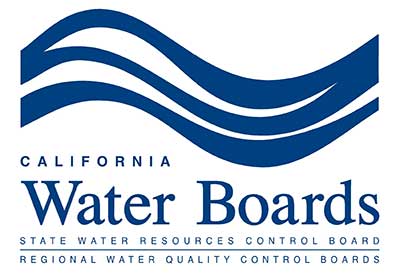
Water Recycling

Our Tertiary Treatment creates super-clean recycled water that meets stringent quality requirements.
Recycled wastewater is produced by treating secondary effluent to the tertiary level. Secondary treated water is mixed with special chemicals that cause any remaining particles to clump together. It is then filtered through carbon and finally disinfected with chlorine to kill bacteria. The recycled water is stored in a 3 million gallon underground tank where it is distributed by the Goleta Water District for irrigation throughout the region, saving precious drinking water. This "purple pipe" water is used on the fields of UCSB, Girsh Park, and golf courses in the Goleta Valley.
Digesters/Bio-Solids Treatment

The digester solids (sludge and scum) removed from the wastewater during the treatment processes contain valuable nutrients, which are recaptured and turned into beneficial biosolids.
The primary solids are mixed with secondary solids that have been collected through the process and are thickened by two mechanical sludge thickeners. They are then stabilized by treating them in three large, heated anaerobic digesters tanks for about 30-35 days. More micro-organisms continue to break down the solids and consume harmful elements. This digestion process produces methane gas, which is captured and used to heat the digesters, creating a closed-loop system. The temperature in the digesters is about the same temperature as the human body, and they function much like our digestive systems.
The digested solids are then further treated in two stabilization basins (lagoons), from six months up to two years. These solids are then harvested out to drying beds where solids are dried in several stages to kill off any remaining bacteria. A portion of these digested solids is sent to two mechanical screw presses where the solids are de-watered and then trucked off-site for land application. The harvested solids product has a dark earthy color, is completely dry, nearly odorless, and is available free to the public as a useful soil amendment. PLEASE NOTE: the availability of free Class A biosolids is subject to various environmental factors. Please call first to confirm if and when biosolids will be available for pick-up.
Limited quantities of Class A biosolids are available on a first-come-first-served basis. For more information please call (805) 967-4519. This material is not to be used as topsoil and it must be turned into your soil. It is not recommended for use with root vegetables. Please bring your own small garbage bags or containers for transport, there is a shovel available for your convenience; we do not have any prepackaged amendment at this time.
Pick up days/hours are M-TH 8-4, Friday 8-3Please make sure to check-in at the administrative office during each of your visits - Thank you.
Process Diagram
